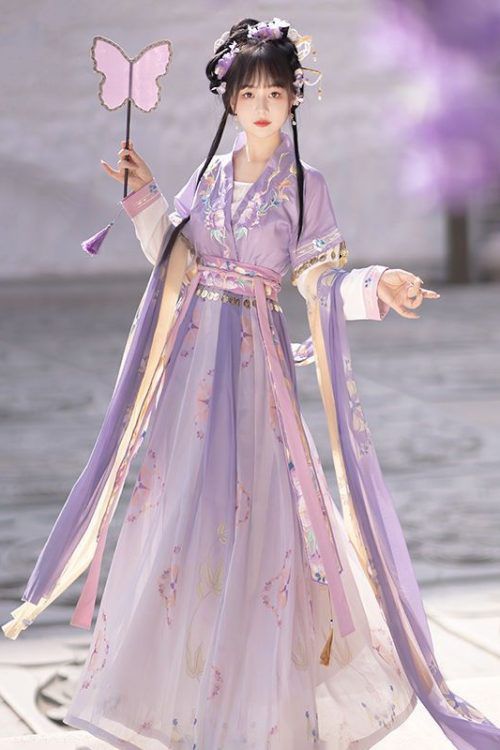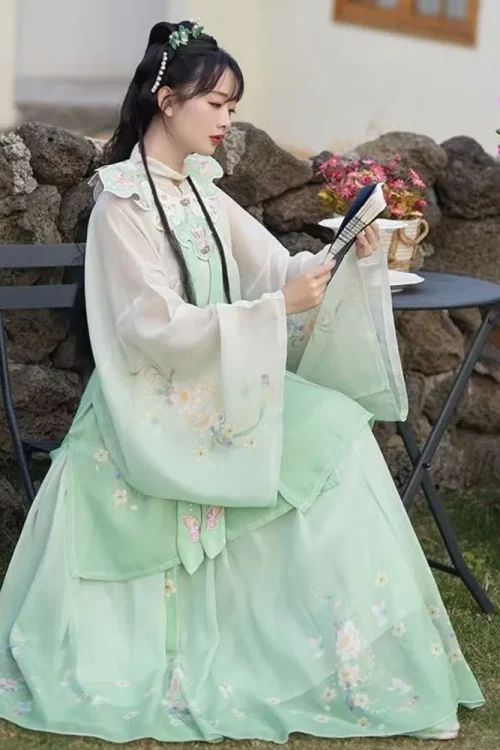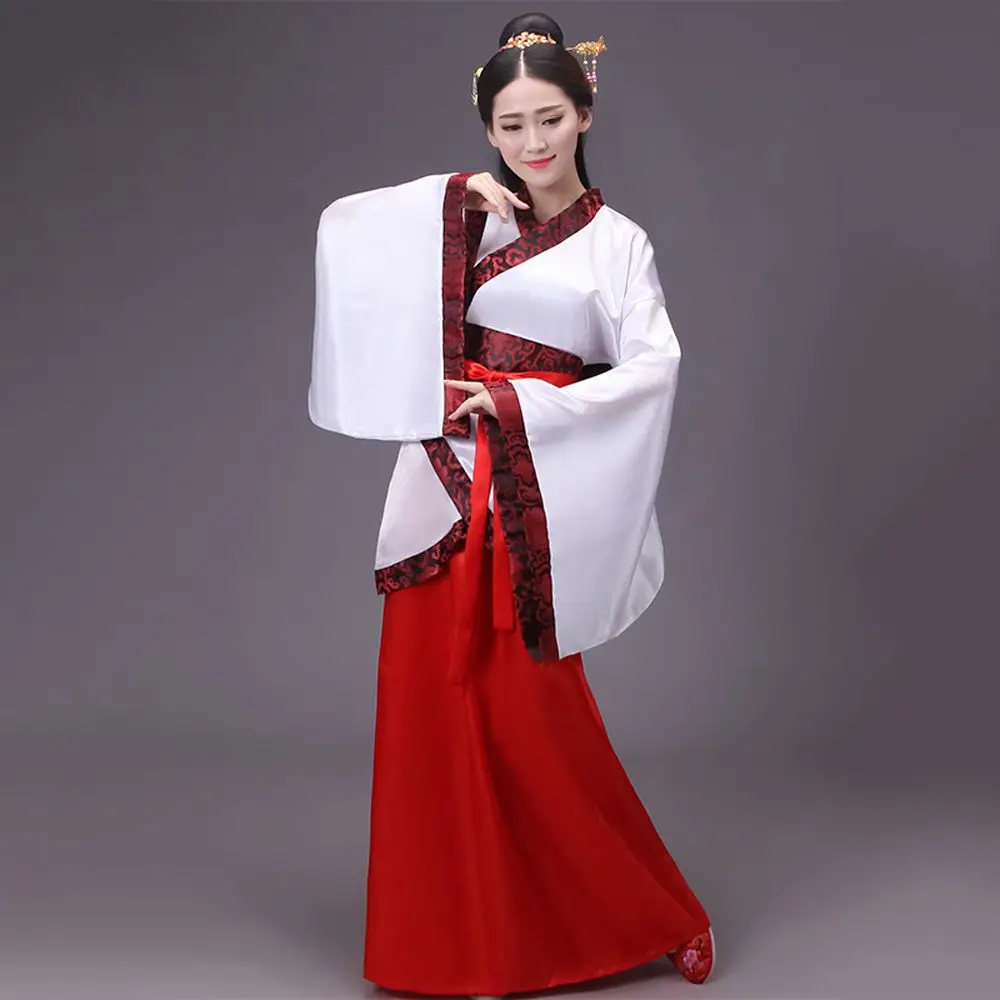Introduction to Cloud Patterns in 汉服
Cloud patterns, an integral part of Hanfu, the traditional clothing of the Han Chinese, have a rich history and profound significance. Their origins can be traced back to ancient times, when clouds were revered as celestial beings and symbols of good fortune.
Cloud Patterns in the Han Dynasty
During the Han dynasty (206 BCE – 220 CE), cloud patterns began to appear on Hanfu as auspicious motifs. These patterns, often depicted as swirling clouds or stylized dragons, were believed to bring blessings and protection to the wearer. As Hanfu evolved over the centuries, cloud patterns became increasingly elaborate and varied.

Peak Popularity in the Tang Dynasty
In the Tang dynasty (618 – 907 CE), cloud patterns reached their zenith of popularity. Tang Hanfu featured intricate cloud designs that covered the entire garment, creating a sense of ethereal beauty. These patterns were often combined with other auspicious motifs, such as phoenixes and peonies, to symbolize prosperity and longevity.
Refinement in the Song Dynasty
During the Song dynasty (960 – 1279 CE), cloud patterns became more restrained and elegant. Song Hanfu often featured subtle cloud designs that were woven into the fabric or embroidered with fine threads. These patterns were often used to create a sense of harmony and balance in the garment.
Stylization in the Ming Dynasty
In the Ming dynasty (1368 – 1644 CE), cloud patterns continued to be popular, but they became more stylized and geometric. Ming Hanfu often featured cloud patterns that were arranged in regular rows or columns, creating a sense of order and symmetry.
Decline and 现代 Revival
After the Ming dynasty, cloud patterns gradually declined in popularity on Hanfu. However, they continued to be used in certain ceremonial garments and as decorative elements in other forms of Chinese art.
Today, cloud patterns are experiencing a revival in popularity as part of the growing interest in traditional Chinese culture. Contemporary Hanfu designers are incorporating cloud patterns into their designs, creating garments that are both beautiful and meaningful.
结论
In conclusion, cloud patterns have played a significant role in the history of Hanfu. They have evolved over the centuries, reflecting the changing tastes and beliefs of the Chinese people. Today, cloud patterns continue to be an important part of Hanfu, symbolizing good fortune, prosperity, and the beauty of the natural world.
The Symbolism and Meaning of Cloud Patterns in Hanfu
Cloud patterns, an integral part of Hanfu, the traditional clothing of the Han Chinese, hold profound historical and cultural significance. Their origins can be traced back to ancient Chinese mythology, where clouds were believed to be the abode of deities and celestial beings. As such, cloud patterns in Hanfu symbolize the wearer’s connection to the divine and their aspirations for a harmonious life.

Cloud Patterns in the Han Dynasty
During the Han dynasty (206 BCE – 220 CE), cloud patterns became prevalent in Hanfu, particularly on the robes of emperors and officials. These patterns represented the wearer’s authority and status, as clouds were associated with the heavens and the imperial court. The intricate designs and vibrant colors of the cloud patterns also reflected the prosperity and cultural achievements of the Han era.
Variations in Subsequent Dynasties
In subsequent dynasties, cloud patterns continued to be an important element of Hanfu, albeit with variations in style and symbolism. During the Tang dynasty (618 – 907 CE), cloud patterns became more stylized and elaborate, often incorporating auspicious symbols such as dragons and phoenixes. These patterns represented the wearer’s hopes for good fortune and longevity.
Naturalistic Approach in the Song Dynasty
During the Song dynasty (960 – 1279 CE), cloud patterns became more naturalistic, with a focus on capturing the ethereal beauty of clouds. These patterns often featured soft, flowing lines and subtle gradations of color, reflecting the refined aesthetic sensibilities of the Song era.
Codification in the Ming Dynasty
In the Ming dynasty (1368 – 1644 CE), cloud patterns became more standardized and codified, with specific patterns reserved for different ranks and occasions. The use of cloud patterns in Hanfu reached its peak during this period, with elaborate and intricate designs adorning the robes of the imperial family and high-ranking officials.

Cultural Meanings and Contemporary Use
Beyond their historical significance, cloud patterns in Hanfu also carry deep cultural meanings. Clouds are often associated with rain, which is essential for agriculture and life in general. As such, cloud patterns symbolize abundance, fertility, and prosperity. Additionally, clouds are seen as a bridge between heaven and earth, representing the wearer’s connection to the divine and their aspirations for a harmonious life.
In contemporary times, cloud patterns continue to be an important part of Hanfu, particularly in traditional ceremonies and cultural events. They serve as a reminder of the rich history and cultural heritage of the Han Chinese people and symbolize the wearer’s connection to their ancestors and traditions.
The Cultural Significance of Cloud Patterns in Hanfu: Past and Present
Introduction to Cloud Patterns in Hanfu
Cloud patterns, an integral part of Hanfu, the traditional clothing of the Han Chinese, hold profound historical and cultural significance. Their origins can be traced back to ancient times, when clouds were revered as celestial beings and symbols of good fortune.
Cloud Patterns in the Han Dynasty
During the Han dynasty (206 BCE – 220 CE), cloud patterns began to appear on Hanfu as auspicious motifs. They were often embroidered or woven into the fabric, representing the wearer’s hopes for prosperity and longevity. As Hanfu evolved over the centuries, cloud patterns became increasingly elaborate and varied.

Zenith in the Tang Dynasty
In the Tang dynasty (618 – 907 CE), cloud patterns reached their zenith of popularity. They were incorporated into the designs of both men’s and women’s Hanfu, symbolizing the dynasty’s grandeur and cultural achievements. The most common cloud patterns during this period were the “auspicious clouds” (ruixiang), which were believed to bring good luck and fortune.
Stylization in the Song Dynasty
During the Song dynasty (960 – 1279 CE), cloud patterns continued to be popular, but they became more stylized and refined. They were often combined with other auspicious motifs, such as dragons, phoenixes, and flowers. This combination of motifs represented the wearer’s desire for a harmonious and prosperous life.
Naturalism in the Ming Dynasty
In the Ming dynasty (1368 – 1644 CE), cloud patterns became more naturalistic and realistic. They were often depicted as swirling clouds or billowing smoke, creating a sense of movement and dynamism. This style of cloud patterns continued to be popular during the Qing dynasty (1644 – 1912 CE).
Contemporary Revival
Today, cloud patterns remain an important part of Hanfu. They are often used in the designs of modern Hanfu garments, representing the wearer’s connection to Chinese culture and tradition. Cloud patterns also continue to be used in other forms of Chinese art and design, such as ceramics, paintings, and architecture.
结论
The cultural significance of cloud patterns in Hanfu cannot be overstated. They are a symbol of good fortune, prosperity, and longevity. They also represent the wearer’s connection to Chinese culture and tradition. As Hanfu continues to be revived and popularized, cloud patterns will undoubtedly continue to play an important role in its design and symbolism.
If you are interested in the traditional Chinese Motifs like the cloud patterns on garments , please click our website: https://cheongsam.net/. You will see other motifs on the traditional Chinese garments including cloud pattern.
